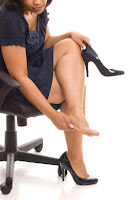 Have you ever heard the saying "Time heals all wounds"? When you are dealing with heel pain, it takes much more time. Some people think that if they have heel pain, it will eventually go away on it's own. They may suffer in pain for six months to a year before they even consider going to a doctor. Unlike most of your other parts of the body, your foot bears the weight of your body. So when your heel is injured, the inflammation persists. Your heel can hurt for a number of reasons, the most common is either tearing or inflammation of the plantar fascia. The plantar fascia is a band of fibrous connective tissue that runs along the bottom of the foot from the heel bone to the toes. When you have this condition, better known as plantar fasciitis, you can have pain that radiates from the heel to other parts of your foot. You can also experience heel pain from poorly fitted shoes to biomechanical problems when you walk or run. Conditions such as rheumatoid arthritis and tendinitis can also aggravate the heel as well. Listed are some tips to help relieve your heel pain.
Have you ever heard the saying "Time heals all wounds"? When you are dealing with heel pain, it takes much more time. Some people think that if they have heel pain, it will eventually go away on it's own. They may suffer in pain for six months to a year before they even consider going to a doctor. Unlike most of your other parts of the body, your foot bears the weight of your body. So when your heel is injured, the inflammation persists. Your heel can hurt for a number of reasons, the most common is either tearing or inflammation of the plantar fascia. The plantar fascia is a band of fibrous connective tissue that runs along the bottom of the foot from the heel bone to the toes. When you have this condition, better known as plantar fasciitis, you can have pain that radiates from the heel to other parts of your foot. You can also experience heel pain from poorly fitted shoes to biomechanical problems when you walk or run. Conditions such as rheumatoid arthritis and tendinitis can also aggravate the heel as well. Listed are some tips to help relieve your heel pain.Loosen Up
When you have a tight heel cord it can cause pain in the heel and in the arch. Stretching this area of the foot can relieve a lot of pain and sometimes make other treatments unnecessary. You should try this exercise first. Stand at arm's length from a wall. Place your palms shoulder-width apart on the wall. Take a step back from the wall with your right foot and bend your left knee slightly. Lean towards the wall and drop your right heel to the ground. You will feel some pull or tightness in the back of your right calf. If this stretch it too uncomfortable, move a little closer to the wall. Hold the stretch for a count of 10 and switch legs. Repeat this exercise 5-10 times per leg. As you are doing this exercise, make sure you are not bouncing on your heel, you want a gradual, gentle stretch.
Opt for Orthotics
Custom-molded orthotics are shoe inserts that can ease your heel pain and perhaps fix the problem that is causing it. When the foot doesn't function properly, certain parts of it such as the heel have to work harder, which causes it to hurt. A prescription orthotic, given by a podiatrist, can correct this condition.
Heal with Medicine
Sometimes a nonsteroidal anti-inflammatory drug like ibuprofen can help reduce any inflammation you might be experiencing. Ask your doctor or pharmacist to recommend one for you.
Replace Shoes Often
Shoes that are worn out won't give your heel the support and shock absorption it needs. You should evaluate your shoes like you would the tires on your car. If the tread goes down or wears unevenly, it's time for a new pair of shoes.
 |
| Dr Jill's Adjustable Heel Lift |
Give Yourself a Lift
If you have plantar fasciitis, a heel lift may provide some relief. This device, which you can purchase through our online store, inserts into your shoe and raises your heel by 1/8 to 1/4 inch. This will take some of the pressure off the point where the plantar fascia inserts into the heel. This will allow the plantar fascia to not work so hard. Cold as Ice
Use cold treatments for the first 48 hours after the pain starts. Simply take an ice cube and massage it into the heel for 5 to 7 minutes, until the area becomes numb. You can do this 3 to 4 times a day or as needed.
Give Your Heel a Cushion
A heel cushion provides support and protection. This can help relieve the pain and swelling. A heel cushion can be purchased in drugstores or at our online store. There are several types of heel cushions as well, from doughnut-shaped to cup-shaped. The type of cushion you should use depends on the nature of your condition. Because of this, you may want to consult your doctor before purchasing one.
If you are still experiencing heel pain without any relief, call 419-423-1888 to schedule your appointment with Dr. Vail. You may also get more information about heel pain by visiting http://www.vailfoot.com/.





No comments:
Post a Comment